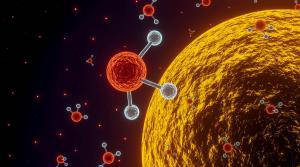What can Astrobiology Space Research Teach Us about the Origins of Life?
Did life originate on Earth, or did it arrive on a meteorite from across the solar system? Find out what space research can teach us about it.
The current theory suggests that it was formed over 2 billion years ago when a massive body collided with the surface of Mars, causing this rock to land about 30 miles away.”
AUSTIN, TEXAS, UNITED STATES, August 3, 2022 /EINPresswire.com/ -- Can Astrobiology Help Us Discover The Origins Of The Building Blocks Of Life?— Formaspace
What constitutes “life,” and how did it begin on Earth?
For centuries, this profound question has occupied inquisitive minds across many fields – from religion and philosophy to biology and organic chemistry.
Today we call the branch of science dedicated to understanding how life came to exist in the cosmos Astrobiology, which seeks to find answers to questions such as:
- How did life begin on Earth?
- Does life exist in other worlds?
- If so, what is the connection between life here on Earth and life in space?
Despite Many Missions To Explore Mars, Finding Contemporary Signs Of Life On The Red Planet Remains A Challenge
Over the years, we’ve sent mission after mission to Mars, seeking answers to these questions.
Despite increasingly clever exploration technology exploring the surface of Mars (including the Perseverance Rover or the Ingenuity Mars Helicopter), astrobiologists haven’t been able to decisively say they have found concrete evidence of current signs of life on the red planet.
Part of the difficulty lies with the extremely harsh conditions. Compared to Earth, Mars has a very thin atmosphere and a weak magnetic field, which means ionizing radiation from the sun blasts the surface every Martian day – drying up the surface and most likely destroying evidence of any organic compounds.
But astrobiology scientists are not giving up. One approach is to look at rock formations on Earth that have similar conditions as Mars; one such place is the Moon Valley in the Atacama Desert in Chile, where researchers are looking at carbonate rock formations to better understand how to identify biomarkers that would indicate signs of life. Another possibility is to equip future exploration missions with the capability to dig deep under the Martian surface to look for signs of water, amino acids, and other organic compounds; however, this might require first building the drilling equipment on the Moon, perhaps as a future extension of the Artemis program.
The New James Webb Space Telescope (JWST) Takes Space Imaging To The Next Level
Maybe there is another way to go about this.
Infrared observations from the new James Webb Space Telescope (JWST) have not only brought us breathtaking new imagery from across the cosmos (including the oldest galaxy we’ve ever seen before), it could transform how we look for signs of the building blocks of life.
For example, the JWST can analyze the atmospheric conditions on remote planets and moons to identify which ones have atmospheric conditions that could support life.
A case in point is the relatively nearby planet Trappist-1e (only 39 light years away), long considered to be a candidate for life on another planet due to its Earth-like conditions. JWST sensors will be trained on Trappist-1e to identify key biosignatures, including atmospheric levels of carbon dioxide, methane, and water vapor.
The engineering behind the James Web Space Telescope is astounding, and the fact that it worked as promised is simply amazing, given that it had nearly 350 potential “single point of failure” modes during launch and deployment. Part of the complication comes from the nature of an infrared telescope itself – which must be shaded from the searing heat of solar radiation that would distort the images gathered by the infrared sensors.
However, we’re not out of the woods yet.
The JWST is large, making it a good target for meteorites, and unfortunately, one recently made a direct hit on one of the telescope’s panels, which may result in permanent degradation in that region.
Are Meteorites A Source Of The Building Blocks Of Life On Earth?
That’s a good segue to our next topic, meteorites, particularly the ones that have crash-landed on Earth.
Can they help us discover the origins of life?
This is both an exciting and controversial topic.
Perhaps the most consequential example to date is the discovery and analysis of the so-called “Black Beauty” meteorite discovered in Western Sahara in 2011, known by its scientific name NWA 7034. Its shiny black surface (basaltic breccia) is reminiscent of the Rosetta Stone in the British Museum.
NWA 7034 has an extraordinary history, first on Mars, then here on Earth.
The current theory suggests that it was formed over 2 billion years ago when a massive body collided with the surface of Mars, causing this rock to land about 30 miles away. Millions of years later, it was hit by another meteorite, and then by a third one, which sent the rock into space where it fell into Earth’s atmosphere – landing on the surface of the Sahara Desert in Western Africa.
Recently, researchers at the Pawsey Supercomputing Research Centre in Australia used an artificial intelligence algorithm to try to identify exactly where the “Black Beauty” was created on Mars. They think they are found the original site of the initial impact as well as the site of the secondary impact that launched the satellite into space and then to Earth.
Julia Solodovnikova
Formaspace
+1 800-251-1505
email us here
Visit us on social media:
Facebook
Twitter
LinkedIn
Legal Disclaimer:
EIN Presswire provides this news content "as is" without warranty of any kind. We do not accept any responsibility or liability for the accuracy, content, images, videos, licenses, completeness, legality, or reliability of the information contained in this article. If you have any complaints or copyright issues related to this article, kindly contact the author above.



